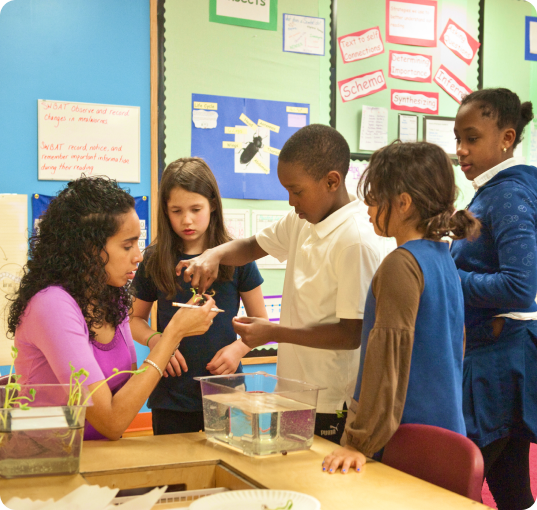Achieve Academic Success with Primary Science Tuition Singapore
Achieve Academic Success with Primary Science Tuition Singapore
Blog Article
A Comprehensive Guide to the Various Learning Methods in Key Scientific Research Direction
The exploration of varied discovering approaches in main science instruction offers a possibility for teachers to enhance student involvement and comprehension significantly. By examining hands-on understanding methods, inquiry-based approaches, and joint approaches, we can determine effective techniques that deal with numerous discovering designs. Furthermore, the assimilation of modern technology and separated instruction plays a crucial function in cultivating an inclusive setting. The concern remains: just how can these approaches be successfully carried out in the class to optimize their effect? The response depends on a more detailed assessment of each strategy and its effects for teaching science.

Hands-On Understanding Strategies
Hands-on learning methods play an essential duty in key scientific research instruction, engaging students in active exploration and testing. These techniques enable learners to communicate directly with materials and phenomena, fostering a deeper understanding of clinical principles. By making use of manipulatives, versions, and real-life experiments, instructors develop a setting where trainees can observe, hypothesize, and evaluate their ideas.
Such techniques not only boost understanding yet likewise cultivate vital thinking and problem-solving abilities. When pupils join tasks like developing easy machines, growing seeds, or performing chemical responses, they are motivated to ask questions and look for responses through their very own observations. This experiential method aids to demystify complex clinical concepts, making them more relatable and available.
In addition, hands-on understanding promotes collaboration amongst peers, as students usually operate in groups to perform experiments or share findings. This synergy not only improves their discovering experience but additionally develops crucial social skills. Inevitably, integrating hands-on strategies in main science instruction promotes a long-lasting love of discovering and curiosity regarding the all-natural world, laying a solid foundation for future academic quests in science and beyond.
Inquiry-Based Understanding
Inquiry-based knowing is an educational approach that motivates pupils to ask inquiries, examine sensations, and construct their own understanding of scientific principles. This method moves the emphasis from traditional teacher-led instruction to a much more student-centered experience, where students take the campaign in their educational journey. By promoting inquisitiveness, inquiry-based learning promotes deeper engagement with the product, permitting pupils to explore topics in a significant context.
In method, this strategy often involves hands-on experiments, monitorings, and vital thinking activities that line up carefully with the clinical technique. Trainees are motivated to develop hypotheses, design investigations, and evaluate data, which cultivates necessary skills such as analytical and analytical thinking. The duty of the instructor in this structure is to promote expedition, assisting pupils via the questions procedure while motivating independent thought and collaboration.
Moreover, inquiry-based learning supports a feeling of ownership over the knowing process, encouraging trainees to go after knowledge proactively. This technique not only enhances understanding of scientific concepts yet additionally promotes a lifelong love for understanding, furnishing trainees with the abilities needed to navigate a significantly intricate globe.
Collaborative Knowing Approaches
Collective learning methods encourage pupils to involve in meaningful communications with peers, cultivating a shared duty for their educational results. In key scientific research instruction, these methods urge students to work together to check out clinical principles, solve problems, and carry out experiments (primary science tuition Singapore). By taking part in team tasks, pupils can utilize varied perspectives, enabling richer understanding and retention of scientific knowledge
One key aspect of collective discovering is the emphasis on Learn More Here communication skills. Pupils must articulate their thoughts, pay attention proactively to others, and negotiate concepts, every one of which are critical competencies in both real-world and scholastic contexts. This social communication not just improves their understanding of scientific principles yet additionally advertises team effort and dispute resolution skills.
In addition, joint understanding usually brings about boosted motivation and engagement. When students see the worth of their payments within a group, they are more probable to take possession of their discovering journey. Teachers can facilitate this process deliberately structured team tasks that straighten with curriculum goals while offering assistance on reliable partnership techniques. On the whole, integrating collaborative discovering methods in key science guideline cultivates a vibrant learning setting that prepares students for future scholastic and social challenges.
Technology Combination in Scientific Research
The integration of modern technology in primary science direction improves finding out experiences by providing innovative tools and resources that sustain numerous teaching methods, consisting of joint understanding - primary science tuition Singapore. The use of digital platforms, simulations, and interactive applications enables trainees to engage deeply with scientific principles, helping with a much more hands-on technique to discovering
Digital research laboratories, for instance, allow learners to conduct experiments safely and efficiently, promoting inquiry-based knowing. These tools can simulate real-world scientific circumstances, permitting pupils to envision intricate processes that would be challenging to replicate in a traditional class setup. Additionally, technology promotes interaction and collaboration amongst pupils, as they can share searchings for and interact on jobs with on-line systems.
Additionally, multimedia discussions and academic video clips can improve lessons by satisfying varied discovering styles, making abstract principles a lot more easily accessible. Data evaluation tools additionally equip pupils to gather and interpret clinical data, strengthening important thinking abilities. In general, the critical consolidation of modern technology in main scientific research instruction not just enhances interaction but additionally prepares students for a highly sophisticated culture, equipping them with necessary skills for future scientific undertakings.
Differentiated Guideline Methods
Set apart instruction methods are essential for attending to the varied demands of learners in main scientific research education. These methods enable educators to tailor their mentor approaches to suit varying abilities, rate of interests, and finding out designs within the classroom. By utilizing separated guideline, educators can develop a comprehensive environment that fosters engagement and enhances understanding of scientific ideas.
One reliable approach is to make use of adaptable organizing, which permits pupils to team up with peers at comparable ability levels or with differing point of views. This strategy urges peer understanding and advertises important reasoning. Furthermore, providing options in assignments can empower pupils, permitting them to pick jobs that reverberate with their rate of interests while still meeting curricular objectives.
In addition, including tiered tasks is one view it now more valuable strategy. By making jobs with varying degrees of intricacy, teachers can guarantee that all students are suitably challenged, no matter their efficiency. Utilizing developmental evaluations to evaluate understanding additional enables educators to change their instructional techniques dynamically, guaranteeing that each student gets the support they require.
Eventually, implementing separated instruction approaches in primary scientific research education not just boosts trainee learning end results but additionally cultivates an enthusiasm for scientific research, preparing students for future scholastic searches.

Final Thought
In recap, reliable primary scientific research guideline necessitates a multifaceted method that encompasses hands-on understanding, inquiry-based approaches, and collaborative strategies. The integration of innovation and differentiated guideline even more caters to varied learning designs, promoting an environment for expedition and crucial reasoning. By applying these techniques, instructors can enhance student interaction and understanding, ultimately nurturing a lifelong interest for scientific research and inquiry. Such extensive techniques are essential for establishing notified and interested future researchers.
The exploration of diverse learning methods in key scientific research guideline provides a chance for educators to enhance pupil involvement and understanding dramatically.Hands-on discovering methods play a critical role in key scientific research direction, engaging trainees in active exploration and trial and error.Inquiry-based understanding is a training method that encourages pupils to ask concerns, examine sensations, and build their own understanding of clinical ideas.Joint discovering methods encourage trainees to engage in significant interactions with peers, cultivating a shared duty for Continued their academic outcomes. Generally, incorporating collective knowing strategies in primary scientific research direction grows a dynamic understanding environment that prepares pupils for future academic and social difficulties.
Report this page